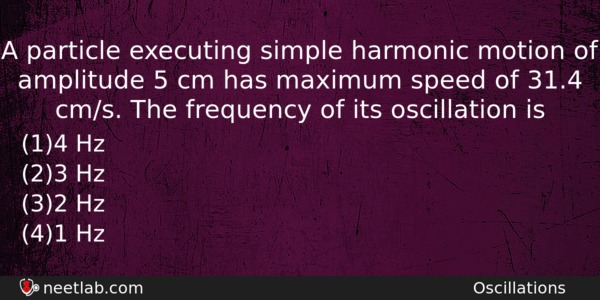| ⇦ | 
| ⇨ |
A particle executing simple harmonic motion of amplitude 5 cm has maximum speed of 31.4 cm/s. The frequency of its oscillation is
Options
(a) 4 Hz
(b) 3 Hz
(c) 2 Hz
(d) 1 Hz
Correct Answer:
1 Hz
Explanation:
a = 5 cm, vₘₐₓ = 31.4 cm/s
vₘₐₓ = ωa ⇒ 31.4 = 2πʋ × 5
⇒ 31.4 = 10 × 31.4 × ʋ
⇒ ʋ = 1 Hz
Related Questions: - A long straight wire is carrying a current of 12 A. The magnetic field at a distance
- Which of the following is the function of the step-up transformer?
- At a given temperature the root mean square velocities of oxygen and hydrogen
- Monochromatic light of frequency 6.0 x 10¹⁴ Hz is produced by a laser. The power emitted
- Two solid discs of radii r and 2r roll from the top of an inclined plane
Topics: Oscillations
(58)
Subject: Physics
(2479)
Important MCQs Based on Medical Entrance Examinations To Improve Your NEET Score
- A long straight wire is carrying a current of 12 A. The magnetic field at a distance
- Which of the following is the function of the step-up transformer?
- At a given temperature the root mean square velocities of oxygen and hydrogen
- Monochromatic light of frequency 6.0 x 10¹⁴ Hz is produced by a laser. The power emitted
- Two solid discs of radii r and 2r roll from the top of an inclined plane
Topics: Oscillations (58)
Subject: Physics (2479)
Important MCQs Based on Medical Entrance Examinations To Improve Your NEET Score
18000+ students are using NEETLab to improve their score. What about you?
Solve Previous Year MCQs, Mock Tests, Topicwise Practice Tests, Identify Weak Topics, Formula Flash cards and much more is available in NEETLab Android App to improve your NEET score.
Share this page with your friends

Leave a Reply